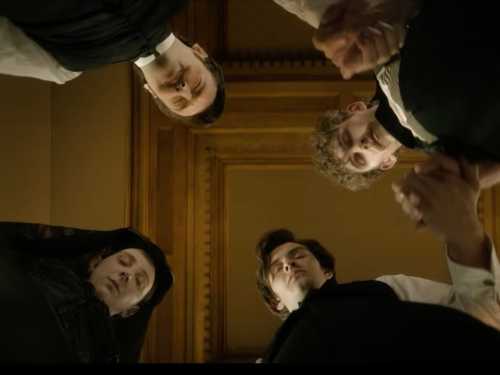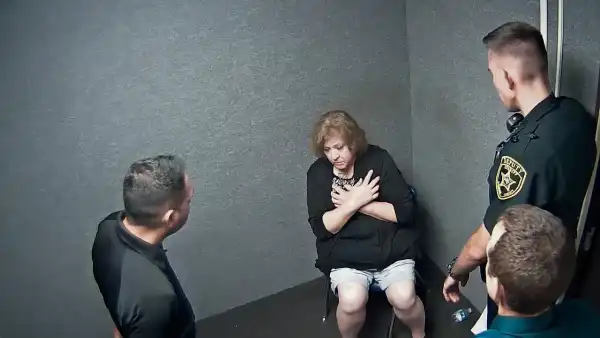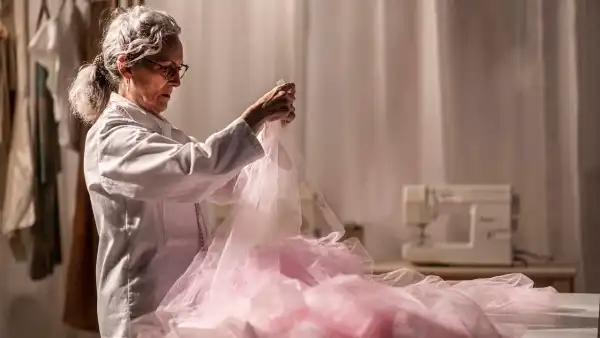
Leilah Weinraub’s début documentary feature, “Shakedown,” which will
screen at moma PS1 on March 18th, explores early-aughts Los Angeles through the underground
black-lesbian strip club from which the film gets its name. This
summary is, as Weinraub acknowledged, a “both crude and accurate”
take on the film. “When I was doing interviews over the years,” she
explained, “a lot of it would be like, ‘How did this evolve? What was
the evolution of this style?’ Of the look, of this ‘high-femme
performance,’ or whatever. And, you know, everybody in the world is like
‘I invented that.’ And I think that everybody is right! But also that’s
very superficial [commentary] about the look [of the film].” As a
director, Weinraub resists operating as a liaison between viewer and
subject; she seems more interested in the play between voyeurism and
fantasy. “Shakedown” is neither an experimental art film nor an
anthropology of gay, black femme performance in L.A. Rather, Weinraub
sought to capture a moment and turn it into cinema.
As a young, aspiring filmmaker, Weinraub was mentored by the director
Tony Kaye, best known for “American History X,” a film whose star,
Edward Norton, rather than Kaye himself, was given final cut. “I was always
really wary of celebrities, ’cause I’m from Los Angeles, and it just
kind of ruins the city, in a way,” Weinraub said. Though disillusioned
by Hollywood’s product—star-led films passed through many hands on their
way to the market—she was enamored by its craft. “[Kaye] shot
everything on 35-mm.,” she said. “Even when he would do documentary
shoots, he shot stuff on 35-mm. black-and-white. Nobody did that.” At
Antioch College, where Weinraub was enrolled in a program called Media
and Social Change, she struggled with the artificial divisions between
approaches to filmmaking. “My bosses at Antioch would be like, ‘You work
in commercial? That’s despicable. We don’t do that. That’s just not
something we do.’ And then commercial people don’t even know about what
else is going on. So there were two influences, I guess.”
“Shakedown,” which runs seventy-one minutes, was carefully culled
from more than four hundred hours of footage that Weinraub shot of the
Shakedown Angels, the club’s roster of all-black female performers, composed of both
femmes and studs. Weinraub began shooting in 2002, when she was
twenty-three years old. She was first brought to the club by a friend
and was so amazed by what she saw on stage that she asked Ronnie—a
charismatic butch lesbian and the club’s owner, m.c., and promoter—if
she could work there. Weinraub started out as a photographer before
moving to videos, capturing sensual, energetic, and lascivious dances by
the Angels, including Egypt, who came into her own lesbian identity
after being exposed to gay night life, and Slim, who impressed audiences
and fellow-strippers with her chameleon-like role-play. “The
performances were exceptional,” Weinraub said. “So I was just trying to
capture them. Just get it right. The room felt extremely special, and I
had never met better people. I was just like, this is it. I’m meeting
legends.” The film studies Shakedown’s heyday, before its main venue was
shut down, by police, in 2004—around the time that the gentrification of
Los Angeles finally manifested as cultural censorship and law
enforcement began to arrest and ticket nude performers for soliciting.
Weinraub is best known as the C.E.O. of the street-wear fashion brand
Hood By Air, which enjoyed critical acclaim and snowballing sales before
going on hiatus, in late 2017. (Hood By Air’s founder, Shayne Oliver,
brought Weinraub on as his partner during a relaunching of the brand, in 2012.)
Informed by her experiences in the film world, Weinraub kept the company
closed to outside investors. In Christopher Glazek’s New Yorker piece about Hood By Air, she described “Shakedown,” which was in the
making long before she entered the fashion business, as an influence for
the brand. At the beginning of the film, the most experienced Angel,
Mahogany—who earned her name because she was “dark and pretty”—explains
the strategy behind her performances, laying out the delicate play
between arousal and entertainment, where movement, undress, personality,
and promotion converge. Similarly, Hood By Air’s social and commercial
clout was rooted partly in the performance of identity at the brand’s
marketing and runway shows.
Weinraub is deeply interested in the work that manifests high-power
performance, and “Shakedown” is constantly interrogating what links
labor and the individual. When Weinraub began filming, more than a decade
ago, she was fixated on the idea of cash economies, on the feel and
look of cash and how it operates in small communities. In the interviews
scattered throughout the film, members of the Shakedown Angels talk
about their relationship to their work. “The idea was, originally, How
do you follow the dollar to trace the community, and how they work
together?” Weinraub said. “But it had to be systematized in some way
that was the right way to do it [for the film]. When we would talk, it
was just like outlining the world: ‘So what do you do? What does that mean? What is it, literally? What is your work? Define it.’ ”
Lately, Weinraub’s been thinking more about the question of labor as it
relates to privacy, of how one can have a space to create, experiment,
and explore without the burden of working just to live. “Is there a
middle class anymore? And, when there was a middle class, and people
really identified with it, was that even real? You’re identifying with
something that’s still taking your life away from you. Do you have time
to live your life, or are you working to live?” Weinraub wonders.
“Egypt’s the last of that generation—her grandfather created a
middle-class family where he thought that his next generation would live
better than him or [be] more stable.” Egypt, like many of the children
of middle-class families today, eventually joined the gig economy. That
her freelance work was stripping, and not writing or dog walking, hasn’t
turned out to be a meaningful distinction, in terms of ownership of
her work. “What I learned about fashion,” Weinraub explains, “is that
you can come up with new ideas, cool, but if you don’t have your own
system, all you’re doing is publishing a new idea so that somebody can
come out there and do it bigger than you can. Not only do you have to
have a concept and an idea that people really respond to but you have
to have the whole infrastructure there to even be able to benefit off of
it.”
Privacy is currency, and the way that it’s often discussed—in
relationship to technology or as a way for upper-class white women to
write novels—ignores the way it has operated in the United States: as an
engine of well-being in a capitalist society, and one that has been
systematically denied to black people from the moment that white people
arrived on the coast of Ghana to begin shipping slaves west. Black
people are at the forefront of culture, but their inventions are and
always have been appropriated without recognition and spread without
attribution. Styles, slang, memes, and music are free for the taking,
whether we like it or not. The Shakedown had a great thing going, but
the privacy it needed to grow and thrive was never guaranteed. Near the
end of the film, Egypt talks about visiting newer black-lesbian
stripping events. She describes being treated like a legend but laments
that the performances are not quite as special. Weinraub feels
similarly. “I don’t have nostalgia for the past; I really don’t,” she
said. “But I just think that something about small scale really changed.
I don’t even know how to describe it. I’m still trying to figure it
out.” “Shakedown”—being neither a commercial spectacle nor a didactic case
study but a torrent of curiosity and fantasy—makes space for itself.
Now it’s up to film distributors to decide how far it reaches.
Sourse: newyorker.com






